Artifacts part 2
VOLTAGE RATIO BOX
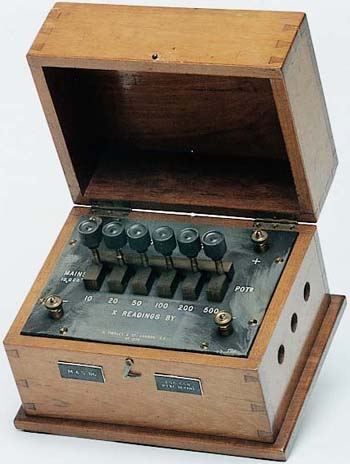
Manufactured by H Tinsley and Company, London. Circa 1930.
The ‘volt box’ or ‘ratio box’ is used in conjunction with a potentiometer if the voltage to be measured is above about 2V. It consists of a high resistance having a number of accurately placed tappings and performs the function of a potential divider.
TECHNICAL DESCRIPTION
Input resistance 10 000 ohms Multiplication factors 10/20/50/100/200/500
Approximate overall dimensions 250 mm x 190 mm x 180 mm
The voltage ratio box is now part of the South African Institute of Electrical Engineers historical collection and can be viewed in Observatory, Johannesburg, South Africa
A PORTABLE CURRENT TRANSFORMER
Made by Ferranti Limited at Hollinwood, Lancashire, England. Circa 1910. The Victoria Falls and Transvaal Power Company Limited (VFP) was the original owner of the instrument.
Ratio 400/5A 7,5VA 50Hz Class AL Tested at 2000V With secondary shorting switch.
A portable instrument in wooden case with leather carrying handle.
It is labelled “VF & TP Co., Ltd. Test Dept.” Approximate overall dimensions 225 mm x 220 mm x 270 mm.
The current transformer is now part of the South African Institute of Electrical Engineers historical collection and can be viewed in Observatory, Johannesburg, South Africa
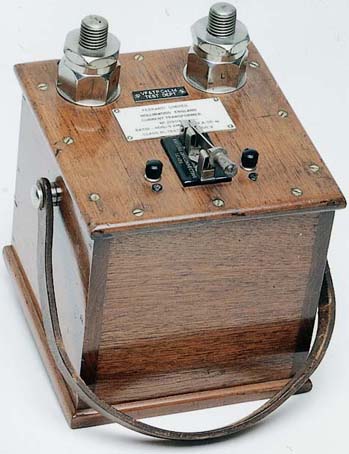
AC/DC PORTABLE WATTMETER
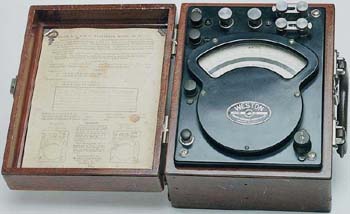
Manufactured in the USA by Weston Electrical Instrument Company, Newark, New Jersey in 1920. It was standardized at Weston Laboratory, Audry House, Ely Place, London.
It is a portable, laboratory type, sub-standard, dynamometer instrument for measuring power in AC or DC circuits.
TECHNICAL DESCRIPTION
Scaled 0 – 120 watts AC/DC Mirror scale
Ranges: Current 2,5 and 5,0 A Potential 50 and 100 V
Power 0 – 120/240/480 W
Range selection by terminals and links Model 310
Portable instrument in wooden case with hinged removable cover, Approximate overall dimensions 210 mm x 270 mm x 150 mm
The wattmeter is now part of the South African Institute of Electrical Engineers historical collection and can be viewed in Observatory, Johannesburg, South Africa.
A PORTABLE AC/DC WATTMETER
Made by Elliot Instruments, United Kingdom. Circa 1940.
It is a portable laboratory type, precision, dynamometer wattmeter, for measuring power in AC or DC circuits.
TECHNICAL DESCRIPTION
Scaled 0 – 110 Mirror scale
Ranges: 0 – 55W and 0 – 110W Range selection by terminals and links.
Max. voltage 110V Max. current 5A Type PL
Correct at 68°F Accuracy % not readable
For use on a bench, the instrument has levelling screws and crossed spirit levels. It is mounted in a wooden case with a lid and carrying handle.
Approximate overall dimensions 215 mm x 280 mm x 240 mm
The instrument is now part of the South African Institute of Electrical Engineers historical collection and can be viewed in Observatory, Johannesburg, South Africa.
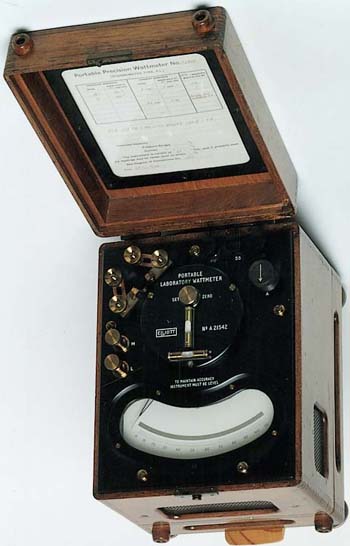
A PORTABLE LOW RESISTANCE OHMMETER Circa 1940
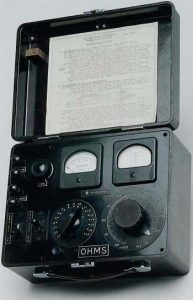
ESCOM’s Test Department is thought to have made the instrument.
The instrument was used to measure low resistance up to 1,8 ohms.
Range 0,1 – 1,8 ohms Detailed operating instructions are shown on the inside lid.
Approximate overall dimensions 295 mm x 240 mm x 170 mm
The instrument is now part of the South African Institute of Electrical Engineers historical collection and can be viewed in Observatory, Johannesburg, South Africa.
A PHASE SPLITTING RESISTANCE BOX
Made by H Tinsley and Company, London. Circa 1930.
The Tinsley Phase Splitting Resistance consists of a variable number of non-inductively wound resistance coils. It is used in series with a variable capacitance to produce the quadrature phase of a 2-phase Drysdale phase-shifter when the available supply is single phase. The Drysdale phase-shifter is an essential component of the Drysdale-Tinsley AC potentiometer used for the accurate measurement of alternating currents and voltages.
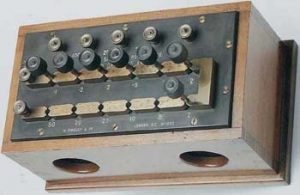
A PORTABLE MILLIVOLTMETER
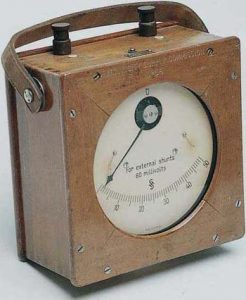
Manufactured by Siemens and Halske, Germany. It is believed it was built circa 1900.
It is a portable, moving coil type that was used with external 60 millivolt shunts.
5 amp shunt multiply the reading by 0,1
20 amp shunt multiply the reading by 0,4
60 amp shunt multiply the reading by 1,0
Approximate overall dimensions 200 mm x 100 mm x 220 mm
The instrument is now part of the South African Institute of Electrical Engineers historical collection and can be viewed in Observatory, Johannesburg, South Africa.
A PHASE ANGLE METER
Manufactured in the USA by Weston Electrical Instrument Corporation, Newark, New Jersey.
The instrument measures the angle between the current and the voltage in an AC circuit when these quantities are represented by vectors.
TECHNICAL DESCRIPTION
Scaled 0 – 90° 180 – 90° 180 – 270° 360 – 270°
Max. Voltage 260/130/75/17,5V Rated Voltage 220/110/65/15
Max. Current 6/3A Rated Current 2,5/1,25A Frequency 50Hz
Range selection by selector switch.
Voltage selection by terminal. Current selection by terminal and link. Model 480
It is a portable instrument in a wooden case with cover and leather carrying handle. Approximate overall dimensions 220 mm x 280 mm x 210 mm. One terminal top is missing.
The instrument is now part of the South African Institute of Electrical Engineers historical collection and can be viewed in Observatory, Johannesburg, South Africa.
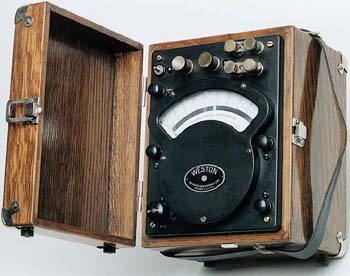
A FLAME-PROOF MINE TELEPHONE
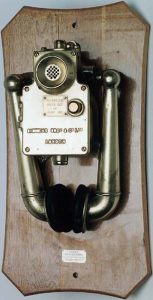
Manufactured by Siemens Brothers and Company Limited, London. Circa 1946. This type of telephone was used in fiery mines and industrial situations with high ambient noise levels.
This particular phone is mounted on a wooden baseboard with an inscribed plaque. The inscription reads “Presented to Mr. H P Alexander as a memento of his association with Colenso Power Station.” Mr. Alexander was ESCOM’s Regional Manager in Natal.
Approximate overall dimensions 320 mm x 190 mm x 610 mm
The telephone is now part of the South African Institute of Electrical Engineers historical collection and can be viewed in Observatory, Johannesburg, South Africa.
A CONDUCTIVITY METER
Made by Evershed and Vignoles, London. Circa 1935.
This instrument was supplied by British Agencies Limited, Johannesburg.
The conductivity meter is essentially a resistance-measuring device arranged to display the reciprocal of the resistance i.e. the conductivity. It has a moving coil movement without control springs but with two moving coils so connected that their resultant torques are in opposition. The one coil carries the current (I), or a definite portion of the current, flowing through the test piece. The other, a current proportional to the voltage applied (V). The displacement of the movement at balance is proportional to the ratio of the two torques i.e. V/I which, by Ohm’s Law, is proportional to the resistance or inversely proportional to the conductivity.
A hand driven generator built into the instrument case provides power.
The instrument is a portable type used to measure the conductivity of earthing systems, electrolytes, etc.
Scaled 0 – 3000 Ranges 0 – 3000/300/30 Patented 1907
The instrument is housed in a wooden case with levelling screws.
Approximate overall dimensions 200 mm x 340 mm x 220 mm
The instrument is now part of the South African Institute of Electrical Engineers historical collection and can be viewed in Observatory, Johannesburg, South Africa.
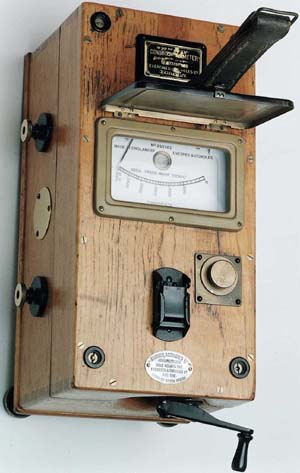
A PORTABLE AC/DC VOLTMETER
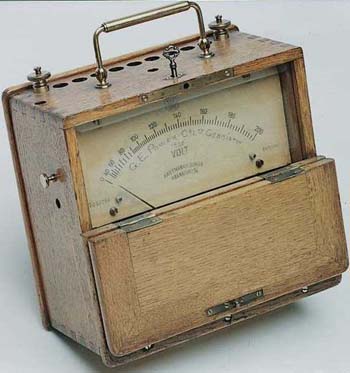
Believed to have been manufactured by Hartmann and Braun, Germany in 1897
It is believed that this instrument was first used by the General Electric Power Co., Ltd., Germiston and was later taken over by the Victoria Falls and Transvaal Power Co., Ltd. (VFP).
It is a portable moving iron type for measuring voltage in AC or DC circuits.
Scaled 0 – 200V
It is housed in a wooden case with a lockable front flap and brass-carrying handle.
Approximate overall dimension 220 mm x 110 mm x 215 mm
The instrument is now part of the South African Institute of Electrical Engineers historical collection and can be viewed in Observatory, Johannesburg, South Africa.
WHEATSTONE BRIDGE
A PORTABLE WHEATSTONE BRIDGE made by H. Tinsley and Co., London. Circa 1940.
This is a portable, laboratory type used for the measurement of medium range resistance.
Ratio arms (by plug setting) 10, 100 or 1000 ohms
Reference standard (4 decades) 0 – 11’110 ohms in steps of 1ohm
The instrument has both Battery and Galvanometer keys, each with provision for locking in the “on” position. Contained in a Teak case without lid.Approximate overall dimensions 395 mm x 215 mm x 150 mm
N.B. This portable version of the Wheatstone Bridge was, at one time, commonly known as a “Post Office Box”
The instrument is now part of the South African Institute of Electrical Engineers historical collection and can be viewed in Observatory, Johannesburg, South Africa.
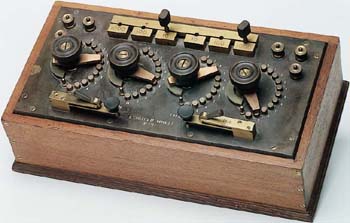
AN ASTATIC ELECTRODYNAMOMETER
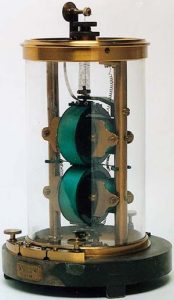
Believed to have been made by Siemens and Halske, Germany in 1887.
Approximate overall dimensions 100 mm diameter x 150 mm
The instrument is now part of the South African Institute of Electrical Engineers historical collection and can be viewed in Observatory, Johannesburg, South Africa.
A UNIVERSAL GALVANOMETER
Made by Siemens and Halske, Germany in 1897.
Siemens and Halske supplied this instrument to the Rand Central Electric Work (RCEW) after the construction of Brakpan Power Station in 1897.
Approximate overall dimensions 200 mm diameter x 100 mm
The instrument is now part of the South African Institute of Electrical Engineers historical collection and can be viewed in Observatory, Johannesburg, South Africa.
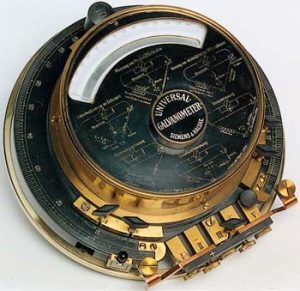
A WHEATSTONE BRIDGE

A WHEATSTONE BRIDGE made by Siemens and Halske, Germany in 1887.
Approximate overall dimensions 100 mm diameter x 150 mm
The instrument is now part of the South African Institute of Electrical Engineers historical collection and can be viewed in Observatory, Johannesburg, South Africa.
AC GALVANOMETER
AN AC GALVANOMETER made in the United Kingdom by H. Tinsley and Company. Circa 1925.
This instrument is a sensitive vibration type 432. It is approximately 150mm in diameter and measures 300mm high. Serial number 13385
The instrument is currently on display at Palmiet Power Station
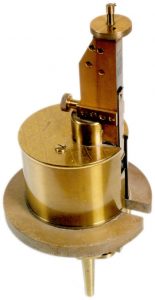
TURBINE CONDENSER VACUUM GAUGE

Turbine condenser vacuum gauge made by Tycos in USA or Canada.
Scaled 0 – 10 inches, and 0 – 5 pounds.
Mounted on a base with approximate overall dimensions 140mm wide x 750mm high.
The instrument is currently on display at Palmiet Power Station.
